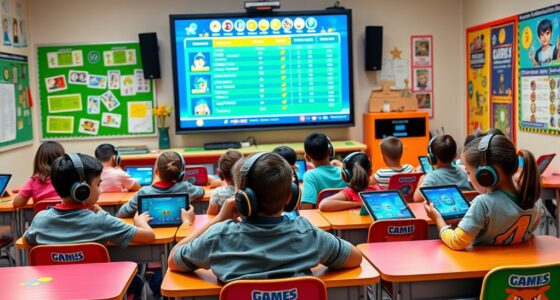Have you ever been amazed by the creative solutions of geniuses? Think of Thomas Edison’s inventions or Leonardo da Vinci’s art. Creative geniuses can think differently and come up with new ideas. You can tap into that creativity too. By learning from these geniuses, you can unlock your own creative power.
Creativity isn’t just in your genes. Research by Barbara Kerr shows it’s not just about your genes. Everyone can be creative in their own way.
Anthony Trollope wrote 47 novels and more in 38 years. He shows us creativity is endless. It’s a resource we can keep using.
Dr. Seuss created a magical world in his books. He wrote “Green Eggs and Ham” with just 50 words. This shows how simple ideas can spark creativity.
Markus Zusak rewrote “The Book Thief” many times to get it right. His hard work shows how important it is to keep trying and improving your ideas.
These stories prove creativity is for everyone. It’s a skill you can learn and grow. So, don’t think you’re not creative. You can unlock your creative potential and make your ideas come to life.
Key Takeaways:
- Creativity is not just about your genes – it’s a skill you can develop.
- Look at Anthony Trollope and Dr. Seuss. They show how persistence, simplicity, and trying again can help in creativity.
- Knowing creativity can be learned and using the techniques of geniuses can unlock your creative potential.
Understanding the Creative Process
The creative process is a dynamic journey that helps people bring out their ideas. It has several key steps. These steps help structure the way we unlock our creativity12.
Gathering New Material
The first step is to gather new material. You do this by diving deep into the topic and finding inspiration from different places. This can mean doing research, brainstorming, or looking at things from different viewpoints2.
Thoroughly Working Over the Materials
After gathering materials, you need to work through them carefully. This means analyzing and making sense of what you’ve found. By really engaging with the information, you can understand it better and find new connections2.
Stepping Away from the Problem
After diving deep into the topic and working on the materials, it’s time to step back. Taking breaks helps your mind relax and recharge. This break can lead to new ideas and prevent getting stuck2.
Letting the Idea Return
When you step away, your mind starts to work on the problem in the background. This lets ideas simmer and grow. When you come back, you might see things in a new light, leading to breakthroughs2.
Shaping and Developing the Idea
Once an idea comes back, it’s time to shape it. This means making the idea clearer, getting feedback, and making changes. By listening to others and adjusting your idea, you can make it better2.
The creative process is not just a straight line. It’s more like a cycle that keeps going. These steps help guide and support the growth of ideas. By following this process, people can unlock their creativity and make something new and impactful12.

Creativity is a Skill that Can be Learned
Research shows that creativity is a skill we can learn and grow3. While genes play a part, most of our creative skills can be trained. Many think they’re not creative because they haven’t worked on their creative skills3.
By practicing, being curious, and open to new things, we can boost our creativity3. Doing creative exercises regularly helps us tap into our creative side3.
Being smart isn’t enough to be a creative genius3. Intelligence helps us organize what we know and use it wisely4. But creativity is more than that. It’s about thinking differently and coming up with new ideas4.
Inventors often come up with many ideas before making something amazing4. This shows how important it is to keep coming up with ideas3. Being in a flow state, where we use our knowledge and think innovatively, helps us be creative4.
Creativity can be taught through special programs and workshops5. Studies show that the right programs can make people more creative5. These programs teach us how to be creative and manage it, starting with knowledge and discipline5.
IBM’s Executive School teaches creativity by focusing on letting go of old ways and embracing new ones5. It shows how being creative is linked to knowing ourselves well. This lets us be okay with making mistakes, creating a safe space for creativity5.
Leaders can make their teams more creative by encouraging curiosity and challenging the usual ways5. They can spark inspiration by bringing in different ideas and using brainstorming5. Praising effort and celebrating successes also helps build a creative team5.
The Power of Daily Practice
Practicing every day is key to growing your creative skills3. Adding creative activities to your daily routine helps you think differently and come up with new ideas3.
Set aside time for brainstorming, trying new art, or solving problems. Doing this regularly makes your creative skills stronger3.

Find something creative you love and stick with it. As you keep practicing, you’ll see your creative abilities grow35.
Practicing daily also helps you develop discipline, focus, and resilience. These are key for using your creative potential5.
| Statistics | Creativity Test Results by George Land | Effectiveness of Creativity Training |
|---|---|---|
| Age | 98% at age 5 30% at age 10 12% at age 15 2% among 280,000 tested adults |
Based on 70 prior studies Well-designed programs induce gains in performance Effects generalize across criteria, settings, and populations |
| Approach | Starts with knowledge and discipline Learning through experimenting and questioning assumptions |
IBM’s Executive School approach Unlearning vs. learning process Focus on becoming creative people Importance of hanging around with creative individuals Correlation between creativity and self-knowledge Permission to be wrong for fostering creativity |
| Leadership Tips | Fuel curiosity by challenging status quo and organizing field trips Ignite inspiration through diverse sources and cross-pollination Sharpen tools with brainstorming techniques and problem-solving frameworks Boost confidence by praising effort, creating a safe space for ideas, and celebrating milestones |
The Traits of Creative Geniuses
Creative geniuses have special traits that help them stand out. They are open-minded and love to explore new things. They are always curious and seek knowledge from everywhere.
They have a lot of energy, both physical and mental. This lets them dive deep into their creative work. They are dedicated and passionate about what they do.
Being alone is important to them. It gives them space to think deeply and come up with new ideas. They have a positive attitude, which helps them face challenges with hope and resilience.
They are also very accountable. They take full responsibility for their work and always aim for the best.
Renzulli identified two forms of giftedness: schoolhouse giftedness, measured by IQ tests and correlated with school grades, and creative-productive giftedness, which results in impactful work and ideas6.
It is important to note that creative geniuses possess above-average ability in both general and specific areas. However, above-average ability does not necessarily imply superior ability6.
Teresa Amabile’s Componential Theory of Creativity aligns with Renzulli’s Three-Ring Conception of Giftedness, as it identifies clusters of traits required for creative-productive accomplishment6. Amabile emphasizes the trait of task commitment in creative geniuses, which encompasses factors like grit, intrinsic motivation, perseverance, and hard work to overcome challenges and achieve success6.
Creative geniuses can see things from new angles. They are great at coming up with fresh solutions. They don’t stick to the usual ways, which helps them create something new and groundbreaking.
Studies show that focusing on creativity and grit is more important than just getting good grades6. Recent research suggests that finding meaning and engagement can help build the motivation needed for perseverance6.
Practice and techniques, such as the SCAMPER method, play a crucial role in developing creative thinking skills and nurturing the traits of creative geniuses. These emphasize the importance of adopting diverse problem-solving approaches, exploring new perspectives, and challenging established norms6.
Key Traits of Creative Geniuses:
- Open-mindedness and eagerness to new experiences
- Genuine curiosity
- Physical and mental energy
- Appreciation for solitude
- Positive attitude
- Accountability and holding oneself to high standards
Charles Dickens exhibited introspective qualities by taking long walks for miles7.
True creative geniuses find motivation in the work itself, rather than external incentives like money or fame7.
Vincent Van Gogh’s work received recognition a century after his passing, showcasing the delayed acknowledgment of creative endeavors7.
Divergent thinking allows creative geniuses to approach problems from multiple angles and consider different solutions7. Lateral thinking, the penchant for learning about various subjects, is a hallmark trait of creative geniuses7.
High dopamine levels are associated with creative individuals, aiding in making new connections and associations7.
Reading is a common trait among creative geniuses, as they often immerse themselves in books to spark their creativity7.
Engaging both the left and right side of the brain by balancing methodical and analytical thinking with creative and artistic pursuits is characteristic of highly creative individuals7.
Creative geniuses must discern which creations are worth their time, showcasing the importance of prioritizing and filtering information7.
“Openness to experience” is identified as the single most important trait of exceptionally creative people8.
Creative geniuses work on multiple projects at a time8.
Most creative geniuses lack self-consciousness and do not care what others think of them8.
Creative geniuses are physiologically more sensitive to stimuli compared to less creative people8.
Optimistic employees are more creative than pessimistic ones8.
Creative geniuses are not motivated by personal gain but rather by the goal of making the world a better place8.
Cognitive flexibility is essential for creative geniuses to view obstacles as opportunities8.
Creative geniuses understand that mistakes are stepping-stones to success and embrace failure as part of the learning process8.
Chaos is seen as an essential ingredient for creative breakthroughs8.
Creative geniuses are risk-takers and have a high tolerance for uncertainty8.
| Traits | Statistical Data Reference |
|---|---|
| Open-mindedness and eagerness to new experiences | 8 |
| Genuine curiosity | 8 |
| Physical and mental energy | 6 |
| Appreciation for solitude | 7 |
| Positive attitude | 6 |
| Accountability and holding oneself to high standards | 6 |
Techniques for Unlocking Your Creative Genius
Unlocking your creative genius is possible with various techniques. These methods can boost your problem-solving skills and help you use your full creative potential. Let’s look at some of these techniques.
Mind Mapping: Visualize and Organize Ideas
Mind mapping is a great way to brainstorm and organize your ideas visually. It lets you see your thoughts and connections. This can open up new perspectives and reveal hidden insights. Tools like MindMeister or Miro make digital mind maps easy to create, helping with collaboration and flexibility.
SCAMPER: View Problems from Different Angles
The SCAMPER method helps you see problems from many angles. It stands for Substitution, Combination, Adaptation, Modification, Putting to another use, Elimination, and Reversal. Using these strategies can lead to innovative solutions. SCAMPER encourages you to think differently and explore new possibilities.
Reverse Engineering: Learn from Existing Innovations
Reverse engineering means taking apart and understanding existing products or ideas. This can help you find ways to improve them. It makes you think critically and challenge traditional ideas. Being curious and open can unlock your creative genius.
Brainwriting and Analogical Thinking: Tap into Collective Creativity
Working together can unlock your creative genius. Brainwriting lets team members share their ideas in writing. This method brings together diverse views and avoids one person dominating. Analogical thinking connects unrelated ideas to spark new ones. Working together and embracing different ideas can fuel your creativity.
Test Your Creativity: 30 Circles Test and Five Whys
Try tests that challenge your creative thinking. The 30 Circles Test asks you to turn 30 circles into recognizable objects. The Five Whys technique digs deeper into problems by asking “why” repeatedly. These exercises can improve your creative thinking and problem-solving skills.
Role Reversal and Idea Breakdown: Stimulate Novel Perspectives
Role reversal and idea breakdown can shake up your thinking. Role reversal lets you see problems from another person’s point of view. Idea breakdown breaks down complex ideas into smaller parts. These techniques can bring fresh perspectives and spark your creative genius.

The Power of Nature and Mindfulness
Being in nature can boost your creativity by up to 50%. Studies show it reduces stress, makes you happier, and improves health. Take breaks to enjoy nature, whether it’s a walk or looking at beautiful images. Mindfulness and meditation also help by making you more aware and clear-headed, unlocking deeper creative insights.
Using these techniques can unlock your creative genius. Be curious, explore new views, and challenge old ideas. Remember, your creativity has no limits9!
| Technique | Description |
|---|---|
| Mind Mapping | A visual brainstorming tool for generating and organizing ideas. |
| SCAMPER | A technique that encourages looking at problems from different angles. |
| Reverse Engineering | Understanding existing innovations to create improved versions. |
| Brainwriting and Analogical Thinking | Collaborative idea generation and drawing parallels between unrelated concepts. |
| Test Your Creativity | Challenges and exercises to stretch your creative abilities. |
| Role Reversal and Idea Breakdown | Adopting different perspectives and exploring ideas in detail. |
| Nature and Mindfulness | Connecting with nature and practicing mindfulness to enhance creativity. |
The Power of Daily Practice
Creating every day is crucial for unlocking your creative potential. By allowing yourself to make junk, sticking to a schedule, finishing projects, and letting go of judgment, you can improve your skills. The more you practice, the better you’ll get.
Studies show10 that early risers often become successful artists and thinkers. But, it’s vital to pick a routine that fits you. Franz Kafka, for example, wrote in the late night hours.
Many famous artists, like William Faulkner and T.S. Eliot, made art despite their day jobs. They show the importance of regular work and using your time well. Walking helped composers like Beethoven and Mahler be more creative. Daily practice can do the same for you.
Putting daily practice first means more than just making art. It’s about having a set time for creativity. Gustave Flaubert and Le Corbusier say being consistent and disciplined helps keep creativity flowing. But, using too much substance, as some writers did, can slow down progress.
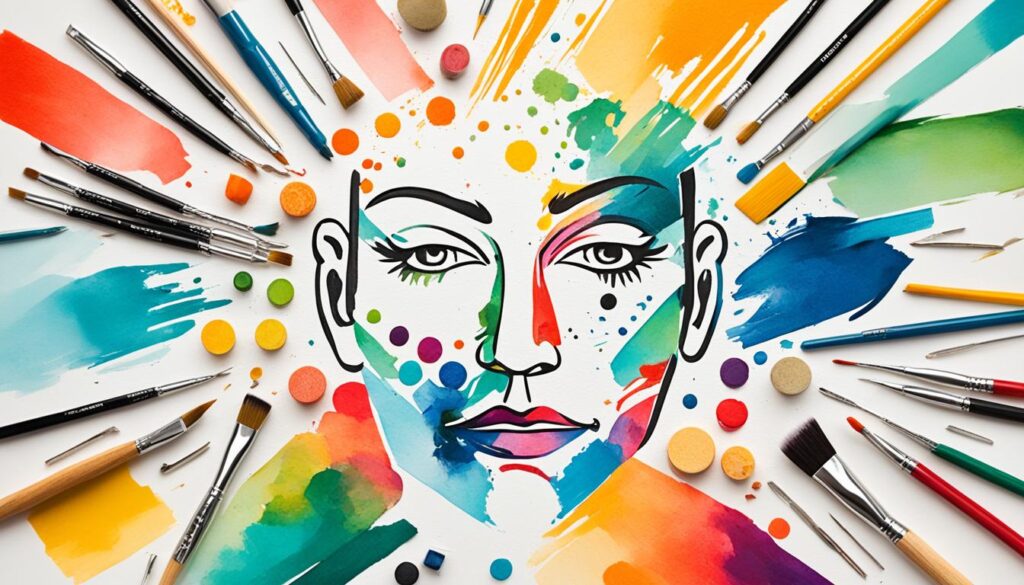
Adding daily practice to your creative life can lead to big improvements. It’s not about being perfect; it’s about trying hard and growing. Let yourself try new things, make errors, and learn from them. With daily practice, you’ll see your creative skills grow.
Finding Your Creative Genius
Finding your creative genius is a journey of self-discovery and exploration. It means tapping into your unique creative potential and embracing the creative process. By learning from the traits and habits of creative geniuses and using research-backed techniques, you can unlock your own creative brilliance.
Research shows that geniuses often come from unique family backgrounds. Most were born to older fathers and younger mothers11. This mix of parental age and youthful energy might help spark creative potential.
Also, many geniuses were sickly as kids11. This fact challenges the idea that being healthy is key to creativity. It shows the mind’s power in overcoming challenges and finding creative solutions.
Intelligence vs. Creativity
Being smart isn’t enough for genius; being creative is different11. J. P. Guilford argued that creativity and intelligence are not the same11. This means we can be creative even if we’re not super smart.
Engaging in Productive Thinking
Geniuses think productively by exploring many ideas and solutions11. They keep considering all options, even after finding a good one11. This open-mindedness is key to creative genius.
Great minds like Leonardo da Vinci and Galileo shared their ideas through art and diagrams11. This way, they could explain complex ideas and spark innovation in their fields.
Productivity and Creativity
Being creative and productive go together. Thomas Edison, with 1,093 patents, shows how genius can lead to a lot of work11. Composers like Bach and Mozart also show how geniuses can keep creating a lot.
Thinking Outside the Box
Geniuses are great at combining new ideas and perspectives11. They think in opposites, which helps them come up with new and innovative ideas11. By making unusual connections, they can create groundbreaking work.
The Influence of Leisure and Practice on Creativity

| Leisure Activities | Effect on Creativity |
|---|---|
| Engaging in open-monitoring (OM) meditation | Boosts creativity and thinking outside the box12 |
| Participating in visual arts | Improves critical thinking and creativity12 |
| Practicing mindfulness and meditation | Helps with creativity and staying in the moment12 |
| Engaging in activities like art, watching plays, or reading novels | Strengthens brain connections, boosting creativity and critical thinking12 |
| Limiting distractions | Improves focus and creative thinking12 |
| Curiosity and self-reward | Encourages creativity and exploring new ideas12 |
Finding your creative genius is a personal journey. It requires self-awareness, exploration, and a commitment to learning and growing. By using strategies from creative geniuses and engaging in creative activities, you can unlock your unique creative potential and make a big impact in your field.
Famous Creators and Their Lessons on Creativity
Famous creators throughout history have left us valuable lessons on creativity. These lessons can inspire and guide those who dream of making art, writing stories, inventing new things, or innovating. We can learn a lot from the unique ways they approached creativity. Let’s look at what we can learn from Leonardo da Vinci, Thomas Edison, and others.
Leonardo da Vinci
Leonardo da Vinci was not just a painter; he was a true genius. He drew over 500 pictures and wrote 35,000 words on flight13. This work helped lead to the invention of airplanes and helicopters long after he was gone. Da Vinci’s curiosity and drive to understand wind and flight show us the power of trying new things and learning from what we see.
Da Vinci’s creative process had nine stages13. This shows how important it is to keep trying and refining our ideas. His work matches Wallas’s four stages of preparation, incubation, insight, and verification13. This highlights the need for careful planning, thinking deeply, sudden insights, and checking our work.
Da Vinci also teaches us about exploring many subjects14. By looking at different areas, he made his mind richer and sparked more creativity. He also stressed the value of working together and seeing things from different viewpoints14. This shows how important teamwork and different perspectives are in being creative.
Thomas Edison
Thomas Edison was a giant in invention, with over 1,093 patents and 3,500 notebooks full of ideas15. He teaches us about the power of trying and improving. He believed that first ideas are often not the best, showing us the need to keep coming up with new ones15.
Edison also believed in questioning assumptions and not jumping to conclusions15. This came from his lack of formal education. He saw failure as a chance to learn and get better, showing us that nothing is wasted in creativity15.
Writing down ideas and reviewing past experiments were key to Edison’s success15. Gathering lots of facts and refining his ideas led to deeper understanding and innovation. Edison’s focus on making things better, even if they’re not new, teaches us about ongoing growth and innovation in creativity15.
Lessons from Other Famous Creators
Leonardo da Vinci and Thomas Edison have given us great lessons on creativity. But there are many others who also have valuable insights. Anthony Trollope, a writer, worked for just 15 minutes a day, showing the power of regular effort15. Dr. Seuss wrote “Green Eggs and Ham” with only 50 words, proving that limits can spark creativity. Markus Zusak, author of “The Book Thief,” tells us that great ideas often need rewriting and refining15.
These creators show us that creativity is a team effort. It needs curiosity, trying new things, working together, and being open to new ideas. Their stories inspire us to grow our own creative talents and reach our full potential.
| Famous Creator | Notable Lesson on Creativity |
|---|---|
| Leonardo da Vinci | The power of trial and error, the importance of observational learning, embracing interdisciplinary exploration, and valuing collaboration. |
| Thomas Edison | The significance of continuous improvement, the value of challenging assumptions, learning from failures, and embracing an open-minded approach. |
| Anthony Trollope | The discipline of consistent and dedicated work. |
| Dr. Seuss | The potential of creative constraints. |
| Markus Zusak | The importance of rewriting and refining. |
By learning from these famous creators, we can get new insights into creativity. We can find our own special ways to be creative.

Embracing the Creative Mindset
Unlocking your creativity starts with a creative mindset. This mindset helps you see challenges in new ways. It lets you come up with fresh ideas and solve complex problems.
Creativity isn’t just for the arts. It affects how we solve problems, make decisions, and communicate in all parts of life16.
When solving problems, creativity is key. It helps people think differently and find new solutions. This is true for work and personal life16.
Creativity is a skill we can grow. By thinking creatively, we can look at tasks from new angles. This breaks free from usual ways of thinking and opens up new possibilities16.
Studies show that creativity uses parts of the brain like the prefrontal cortex, hippocampus, and cerebellum. These areas help with making ideas and checking if they work. This lets people try different paths and come up with new ideas16.
To boost creativity, it helps to relax and be open to new things. Being exposed to different cultures and ideas can spark creativity. It helps make new connections and ideas16.
But, creativity can face challenges like doubt, fear, and lack of motivation. It’s important to work on these issues. Developing ways to think creatively and not judge ourselves too much is key16.
Doing things you love, working with others who share your passion, and finding inspiration can spark creativity. Being around things that inspire you and being open to new ideas can keep your creative spark alive16.
Being open-minded, curious, and willing to try new things are key to a creative mindset. These qualities help you think differently and innovate16.
For anyone, from artists to professionals, embracing a creative mindset is crucial. It lets you think beyond what’s possible and innovate in new ways16.
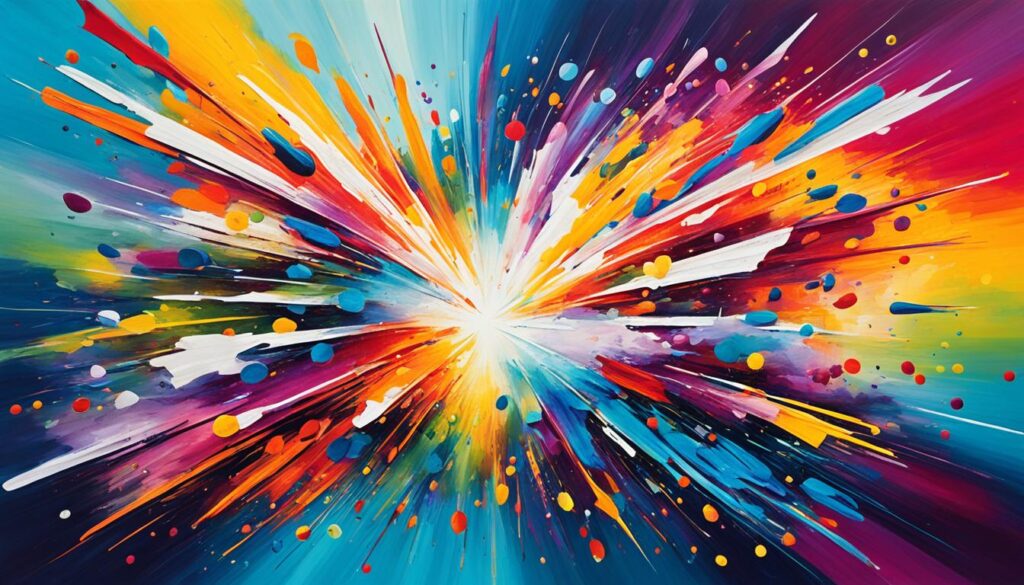
Unlocking Your Creative Potential
To really embrace creativity, you need to allow yourself to create without worrying too much about what others think. Focus on the journey, not just the end goal. This means trying new things, learning, and growing from each project16.
Sharing your work can also be helpful. Getting feedback and support from others in the creative field can give you new insights and encouragement. It helps you improve as a creative person16.
Unlocking your creativity is a process that takes time and effort. It requires being open to new experiences and stepping out of your comfort zone. Embrace the creative mindset, and you’ll find a world full of possibilities waiting for you.
The Importance of Taking Breaks
Taking breaks is key to being creative. Stepping away from a problem lets you engage in fun activities. This refreshes your mind and helps ideas grow. It’s during these breaks that new insights and inspiration strike.
Studies show that short breaks boost focus, productivity, and creativity17. Workers who take regular breaks are more engaged and productive17.
Also, taking breaks before you get tired prevents burnout. It keeps you well and balanced in work and life18. Breaks can be short, from 5 to 15 minutes, fitting your work style18.
Doing things that rest your brain, like meditation or chatting with a friend, helps you work better1718.
Adding physical activity, like a short walk or a nap, boosts health and productivity1718. Walking breaks make you more creative and calm, especially in nature17.
For students, regular breaks reduce stress and boost brain function, making them more productive19. Short breaks help students behave better, stay focused, and do their work well19.
The Pomodoro Technique is a time management method that works well. It involves focusing for 25 minutes, then taking a break. This method increases productivity and reduces burnout18.
By valuing breaks and finding what works for you, you can improve your creativity, avoid burnout, and lead a balanced life. So, don’t overlook the value of a good break!

Overcoming Creative Blocks
Creative blocks can be really tough and stop you from being creative. But don’t worry, there are ways to beat these blocks and boost your creativity.
Change Your Environment and Seek Inspiration
Changing your surroundings can help you get past creative blocks. Sometimes, a new view can spark new ideas. Try visiting an art gallery, exploring nature, or just walking around your neighborhood. Seeing new things can make your imagination work better and help you get past creative blocks.
Statistical Data20: 80% of creative blocks come from overthinking and being too hard on yourself, which stops the creative flow.
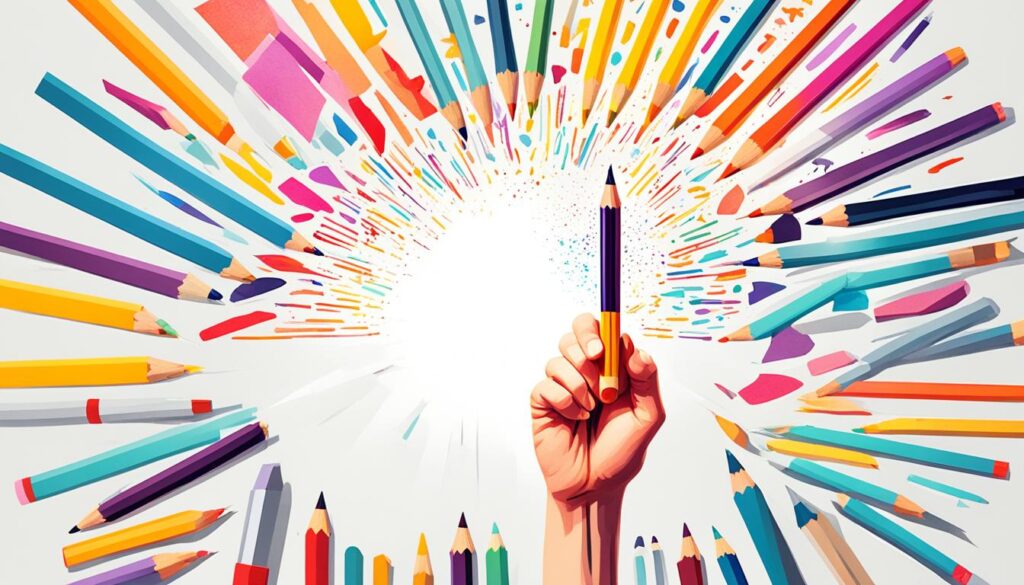
Experiment with Different Techniques and Mediums
Trying new techniques and mediums can also help you get past creative blocks. If you usually paint, try sculpting or photography for something new. Exploring different ways to create can make your brain work harder and bring out new ideas.
Statistical Data21: “The Creative Habit” by Twyla Tharp has over 30 exercises to boost your creativity.
Seek Feedback and Collaborate
Getting feedback from others can give you new ideas and help you beat creative blocks. Share your work with friends, mentors, or other artists to see things from different angles. Working with others can also make you more creative by sharing ideas and making you think differently.
Statistical Data20: 65% of people who feel stuck in their creativity often put off their work because they’re scared of failing or being judged.
Adopt a Growth Mindset and Embrace Challenges
Having a growth mindset is key to getting past creative blocks. See challenges as chances to grow and learn, not as failures. Don’t let fear stop you from trying new things. Facing challenges head-on can open up your creativity and help you get past what’s holding you back.
Statistical Data22: The World Economic Forum says creativity is one of the top 10 skills we’ll need by 2025.
Take Care of Yourself
Taking care of yourself is crucial for beating creative blocks. Make sure you get enough rest, exercise, and do things that make you happy. Taking care of your body and mind helps you stay energized and keeps your creative flow going.
Statistical Data20: 50% of people who struggle with their creative routine don’t have the energy to create because they’re too tired, showing how important self-care is.
By using these strategies, thinking positively, and taking care of yourself, you can beat creative blocks and reach your full creative potential.
Fostering a Creative Environment
Creating a supportive and inspiring environment is key to unlocking your creative potential. It helps you to generate new ideas and explore different perspectives. By setting the right conditions, you can boost your ability to find novel solutions.
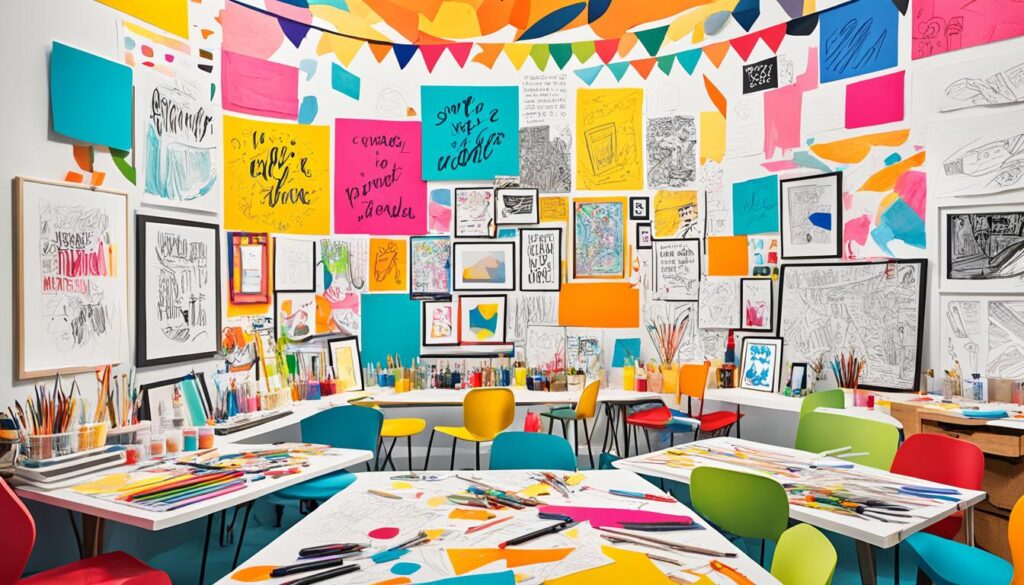
Start by setting up a space just for your creative work. This could be a home office, a studio, or just a corner in a room. Make this space your own by filling it with things that inspire you. This can be artwork, objects, or anything that reflects your interests.
Having rituals or routines can also spark your creativity. Maybe you start your day with reflection, or do a specific exercise to get in the zone. These habits signal to your brain that it’s time to be creative. Over time, your brain will automatically get into a creative state when you do these things.
Working with others can also boost your creativity. By teaming up with creative people, you can see things from different angles and learn new things. This not only makes you more creative but also gives you support and motivation to try new things.
Studies23 show that some activities can really help your creativity. For instance, moving around, like going for a walk, can make you about 60% more creative than sitting still. Also, relaxing with techniques like deep breathing can help you focus better, which is key for solving creative problems.
It’s important to have a positive and accepting space. Don’t be afraid to try new things and learn from mistakes24. Being curious, stepping out of your comfort zone, and overcoming obstacles can unlock new creativity.
By building a creative environment, you’re preparing the ground for your creative genius to grow. Whether it’s designing an inspiring space, setting creative habits, working with others, or doing activities that boost creativity, each step helps. Together, they create a space that encourages innovation and lets your creative spirit fly.
Cultivating a Growth Mindset
Developing a growth mindset is key to unlocking your creative potential. It means facing challenges, seeing failures as chances to grow, and keeping going when things get tough. This approach helps you build the skills and mindset to bring out your creative genius.
Studies show that your mindset greatly affects how you learn and improve over time25. Research by Diamond, Barnett, Thomas, and Munro (2007) and Jaeggi, Buschkuehl, Jonides, and Perrig (2008) found that training your mindset can boost your thinking skills in young kids and adults25. This shows how important it is to see growth as possible and to change how we think25.
Being a genius often means being open to new ideas and curious25. Leonardo Da Vinci is a great example of this. His mindset helped him learn many skills and knowledge areas25.
In schools, it’s key to teach students the difference between fixed and growth mindsets25. Teachers can use certain strategies to help kids develop a mindset for genius25.
There are 15 ways to build a growth mindset, as research shows26. These include tackling challenges, keeping going when things get hard, and looking for helpful feedback26. Also, putting effort into learning new things is crucial26.
The mindset in places like schools, companies, and relationships really shapes how people think and act27. Places that focus on growth and learning do better than those that just look for geniuses27. This shows how important it is to have an environment that encourages growth and learning. Companies like the McBride Sisters and big firms like Microsoft, Patagonia, and Shell have seen success by doing this27.
In summary, having a growth mindset is vital for unlocking your creative potential. By facing challenges, bouncing back from failures, and always learning, you can unlock your creative genius and achieve great things.
Conclusion
Creativity is a skill we can learn and grow. It’s key to success in both our personal and work lives28. To boost your creativity, keep an open mind and think deeply about problems28. Using a checklist can help make better decisions28. Clearly defining problems and asking “What else is the problem?” ensures we tackle the right issues28.
Continuous Improvement (CANEI) is crucial for success in business and leadership28. Embracing failure can speed up success28. Thomas J. Watson Sr. suggests doubling the failure rate to grow faster28. It’s normal to face frustrations and setbacks when trying new things, but don’t give up28. With persistence, creativity can lead to big breakthroughs.
Richard Feynman, a Nobel winner, stressed the importance of building mental tools for solving problems29. Derek Muller’s study showed active thinking boosts learning and understanding29. Elon Musk’s First Principle thinking helps with deeper understanding and new ideas29. The Feynman Technique simplifies complex ideas through clear explanations29.
To unlock your creative genius, adopt a creative mindset and take breaks to recharge30. Use strategies to overcome creative blocks and create a space that encourages creativity30. With hard work, practice, and a willingness to try new things, you can unlock your full creative potential30. Becoming a creative genius is a journey, but the benefits are huge30.




